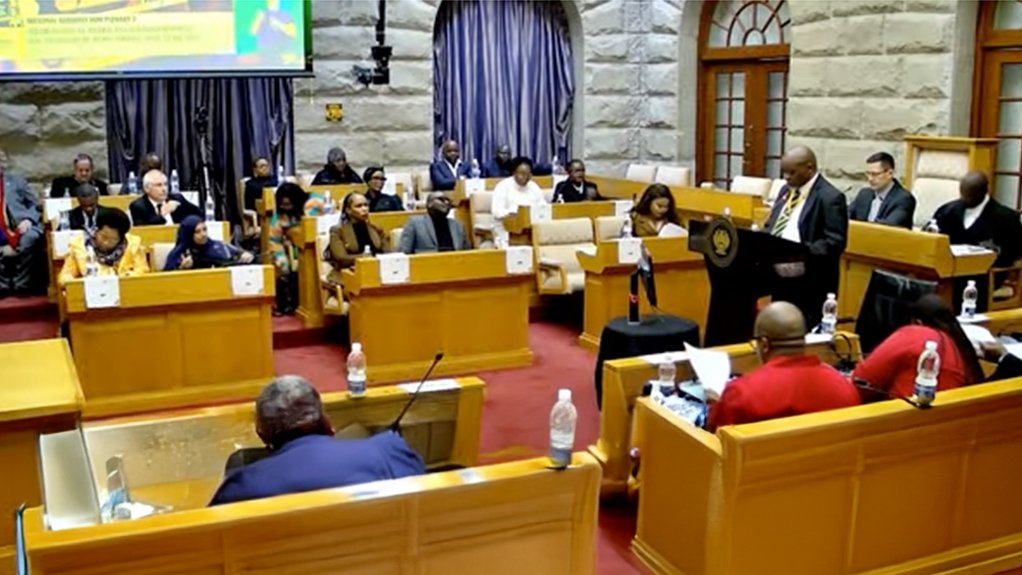JOHANNESBURG (miningweekly.com) – South Africa’s derelict and ownerless mine rehabilitation programme has gone beyond rehabilitation to include the closure of hazardous old shaft openings as well as apertures created by illegal mining activities, Mineral and Petroleum Resources Deputy Minister Phumzile Mgcina outlined to Parliament during this week’s budget vote 2025.
“Given the additional funding of R180-million for the derelict and ownerless mine rehabilitation programme during the previous financial year, I can report to you that Mintek has successfully rehabilitated at least four asbestos mines in Limpopo and Northern Cape and closed a total of 280 mine openings,” Mgcina reported.
For the current 2025/26 financial year, the Mineral and Petroleum Resources Department (MPRD) has been allocated R2.86-billion, of which R1.16-billion, or 40.55%, would be transferred to public entities, municipalities, and other implementing institutions to enable them to fulfil their constitutional mandates, Mineral and Petroleum Resources Minister Gwede Mantashe told Parliament.
Adding to the operational funding for the entities was, Mantashe outlined, an allocation for specific projects including R134.7-million for the rehabilitation of derelict and ownerless mines implemented by Mintek, R22.4-million for the Mine Rehabilitation Research Project implemented by the Council for Geoscience (CGS), and R32.3-million allocated to the CGS for the Mine Water Ingress Project.
In cognisance of the dangers associated with derelict and ownerless mines, Mintek, the Deputy Minister pointed out, had made significant strides in addressing this pressing issue.
“These efforts have not only led to improvements in environmental and health outcomes but have also provided a positive economic impact. On average, each rehabilitation site has created 60 job opportunities for local community members, contributing to local economic growth.
“If we are to address the legacy of derelict and ownerless mines across the country and contribute to a safer and healthier environment, much more work remains to be done, hence we welcome the additional funding for this programme during the current financial year,” Mgcina commented during her budget vote speech covered by Mining Weekly.
In partnership with the Mining Qualifications Authority, Mintek had, the Deputy Minister revealed, made progress in supporting aspirant artisanal and small-scale miners by empowering them with the expertise required to participate in the mining industry through the skills training programme.
“By the end of the previous financial year, at least 300 learners across the country have been equipped with valuable skills for a career in mining.
“This initiative exemplifies our commitment to fostering inclusive economic growth, gender equality, and social empowerment in the mining sector,” Mgcina reported.
This follows the enactment of the Artisanal and Small-Scale Mining Policy in 2022.
CARBON CAPTURE AND STORAGE
The characterisation of geological sites for the permanent storage of CO2 had also been made by CGS on a pilot site in Mpumalanga, where the Carbon Capture, Storage and Utilisation project had, Mgcina said, outlined the preliminary findings on suitability to store carbon in a safe manner.
Further research on the capture and utilisation aspects of carbon would continue, as well as how this could relate to the establishment of carbon trading markets.
To realise this ambition, a collective approach by government and business would will be required, the Deputy Minister added.
DIAMOND TURNAROUND
Parliament was told that the challenges faced by South Africa’s diamond sector threatened its contribution to inclusive economic growth. These included the competition from lab-grown diamonds, economic and geopolitical risks, access to finance for emerging beneficiation businesses, and the decline in production at the Venetia diamond mine in Limpopo, owned by De Beers.
To ensure the resilience and competitiveness of South Africa’s diamond trade, the South African Diamond and Precious Metals Regulator would, Mgcina reported, implement a turnaround strategy involving the integration of digital technologies to improve trade efficiency, transparency, and accessibility.
To this end, funding has been allocated to ensure the successful implementation of these strategic initiatives, including the promotion of natural diamonds through marketing such as the diamond show which was hosted by the State Diamond Trader in February.
As part of government’s concerted efforts to ensure that every mineworker returns home unharmed every day, the Mine Health and Safety Council and the department hosted a summit in October to achieve the goal of zero harm.
The 42 fatalities recorded in 2024 were South Africa’s fewest ever and that combined with the decrease in occupational injuries demonstrated that the goal of zero harm could be attained sooner than imagined through collaboration.
RE-INDUSTRIALISATION OBJECTIVES
In keeping with the National Development Plan Vision 2030, the Medium-Term Development Plan and the government’s objectives of re-industrialisation, the MPRD had, Mantashe reported, anchored its strategy around an enabling policy and regulatory environment. To support this priority, resources would, he said, be provided for the review of policies and legislative instruments to underpin value addition close to the points of production.
Policies would be driven to enable greater participation of the historically disadvantaged and environmental sustainability would be assured through enhancing compliance and rehabilitating derelict and ownerless mines.
EMAIL THIS ARTICLE SAVE THIS ARTICLE ARTICLE ENQUIRY FEEDBACK
To subscribe email subscriptions@creamermedia.co.za or click here
To advertise email advertising@creamermedia.co.za or click here











